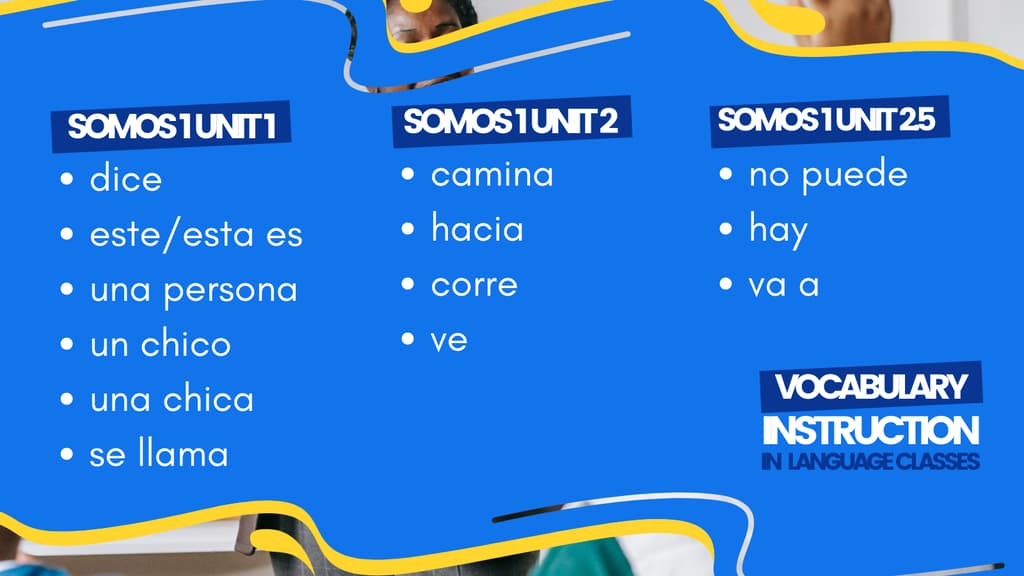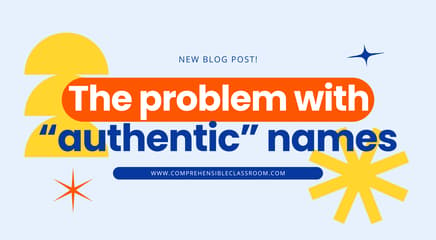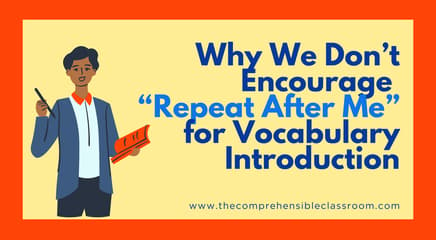Many of us learned language through an explicit instructional model, in which words and concepts were taught, practiced, and memorized. When I began teaching, I started out with that same explicit model of instruction: working from a textbook curriculum that laid out thematic vocabulary to memorize and grammar concepts to practice and master in each chapter.
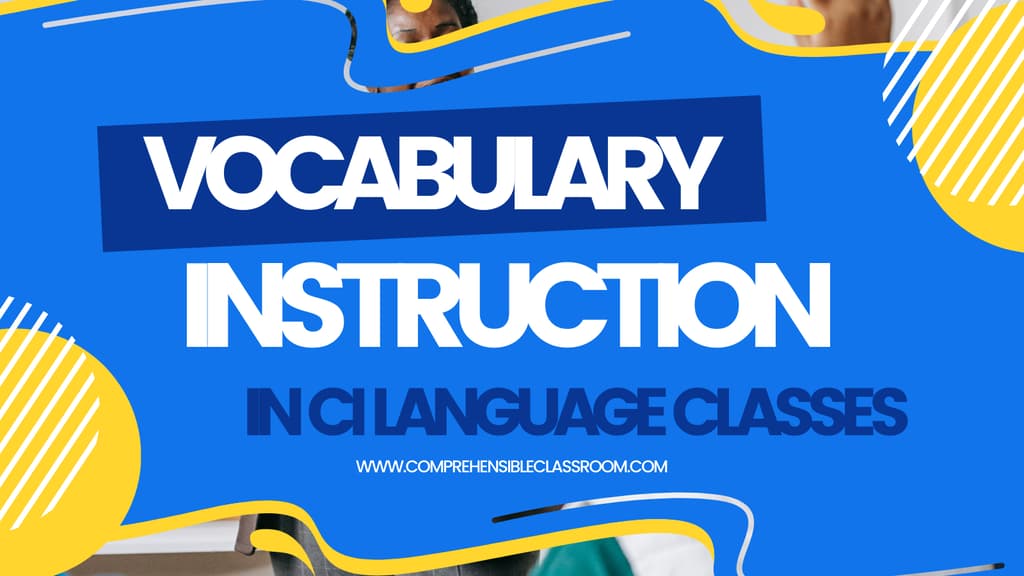
The role of vocabulary in implicit instructional models
Toward the end of my first year of teaching, I learned that there was another way to help students build linguistic competence. I learned that my students could become proficient in Spanish using the same process through which I have become proficient in my first language. This process is called language acquisition, and it is different than language learning.
Dr. Stephen Krashen posited that "We acquire language when we understand messages; when we understand what people tell us and when we understand what we read". This acquisition of language that happens through exposure to Comprehensible Input is implicit and subconscious, and it eliminates the need for explicit vocabulary instruction and practice.
Teachers that label themselves as "Acquisition Driven" or "CI/Comprehensible Input" teachers have chosen to focus instruction on fostering language acquisition, not language learning. We say very often that because language is not stored in lists or categorized by rules in our brains, we do not present language to students in lists or through explanations and practice of rules and patterns. Rather, we use language naturally, in a sheltered manner that promotes comprehension, and allow students’ brains to do the natural work of language acquisition.
In a workshop at the Southern Council on Language Teaching (SCOLT) Conference this weekend, 2022 SCOLT Teacher of the Year Claudia Elliott described this difference in instruction between the two instructional models:
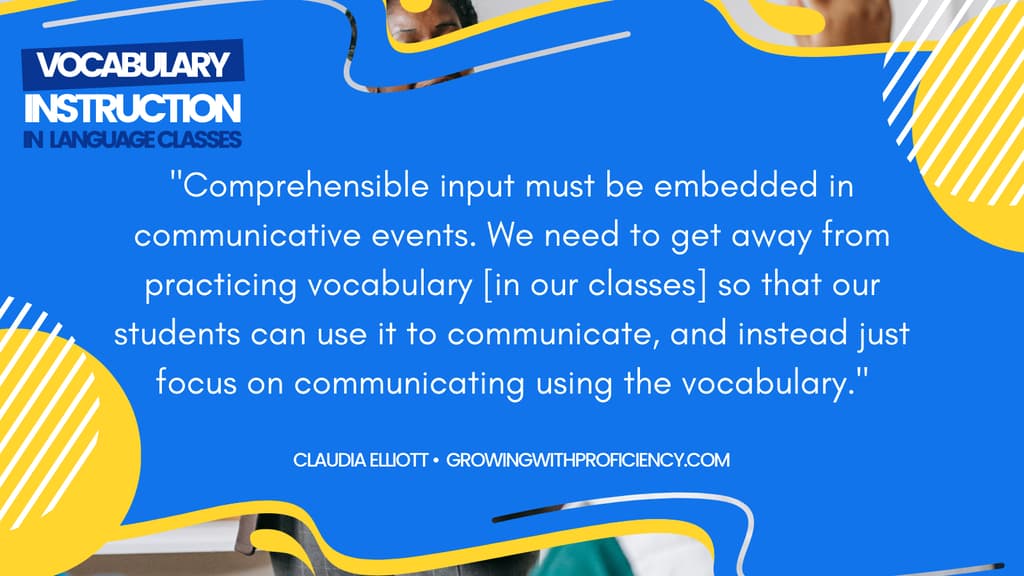 Claudia Elliott, 2022 SCOLT Teacher of the Year, shared this quote during her workshop on creating a Scope and Sequence. Click here to connect with Claudia!
Claudia Elliott, 2022 SCOLT Teacher of the Year, shared this quote during her workshop on creating a Scope and Sequence. Click here to connect with Claudia!
In Acquisition Driven language classes, teachers create lesson plans with a communicative purpose in mind (telling a story, having a conversation, playing a game, etc.) and plan for how they will help students to understand the communication. Vocabulary is of course used to communicate, but the purpose of the lesson is communication, not vocabulary knowledge.
Visit Claudia's website to learn more about Teaching for Acquisition and to find acquisition-focused materials for upper levels, including AP!
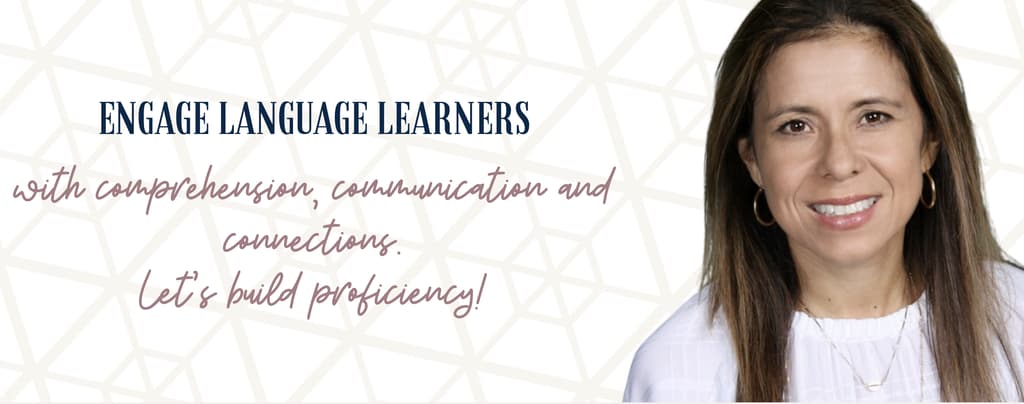
Why do some "CI lessons" come with vocabulary lists?
The Somos* family of curricula provide an implicit model of language instruction. Every lesson is designed to promote language acquisition by establishing a purpose for communication and equipping teachers with tools to help all students be able to engage in those communicative contexts by making and keeping language comprehensible.
It may seem surprising, then, that The Somos* Curriculum actually comes with a vocabulary list. In every unit, there is a list of approximately three vocabulary words or terms that are labeled as “Core Vocabulary”. In fact– a quick look at lesson plans and materials from many different publishers and teacher-authors that share Comprehension-based lesson plans will show that it is quite common to see a vocabulary list with these lessons!
What gives?
*Note: we use the asterisked term "Somos*" to reference all curricula in the family: Somos (Spanish), Nous sommes (French), and Sumus (Latin).
Where did Core Vocabulary come from?
The Core Vocabulary for Somos initially came from a backward planning process. I originally developed The Somos Curriculum for my own Spanish classes. When I was transitioning from an explicit instructional model to an acquisition-focused, implicit instructional model, one of my goals was to read a novel with my students at the end of a school year. In order to ensure that my students would be able to read the novel, I knew that they would need to be able to interpret the important words that were used to tell the story. To that end, I created a list of those words and began considering how I could use those words in class in the months leading up to the reading of the novel so that my students would be able to read and understand them with confidence in the context of the novel. This process of backward planning from a word list was modeled for me by Carol Gaab, then-President of Fluency Matters, now owned by Wayside Publishing.
Some of the ways in which students could see the words and become familiar with them include:
- Storyasking (TPRS® - the class co-creates a story)
- Storytelling (the teacher tells a story to the students)
- Personalized Questions and Answers (PQA - the class discusses questions about their lives and ideas)
- ClipChat (the teacher narrates a short video to the class)
- Topical readings (the class reads about a cultural or other topic)
These activities formed the basis of the curriculum that I was developing for my students, and each activity or topic was chosen strategically for the purpose of exposing students to one or more of the vocabulary words from the list with the hope that by the time that they would begin reading the novel, enough of the words in the text would be familiar enough to students that they would be able to read the novel with ease.
The role of Core Vocabulary
As the individual pieces of the curriculum took shape, I began to work out a sequence for the communicative activities that I was planning so that not only were students being exposed to the words from the novel in one particular context, but repeatedly throughout the course of the year. By continuing to use the words from the first story of the school year in the second story, and the third, and the fourth, students’ acquisition of vocabulary was supported through the frequency effect. While a range of new words were used in every communicative activity throughout the school year, a core set of words were used and reused in every unit. Some new words were spiraled into the core set, becoming words that were recycled in every subsequent unit, while other new words were used only in the context of that unit, and then often not seen again. The words that were recycled in subsequent units were labeled Core Vocabulary, as they are at the core or center of all communicative exchanges throughout the curriculum.

Expectations surrounding Core Vocabulary
Every Somos* Unit features a set of Core Vocabulary words. These are the words that are at the core of communication for that unit. While the expectation is that these words are new to students at the outset of the unit, it is often the case that students have previously heard or read the Core Vocabulary terms. There is no harm in teaching a unit that uses Core Vocabulary that your students can already interpret or produce. If the Core Vocabulary words are new to your students, then following the suggested lesson plans as written should provide your students with sufficient scaffolding to develop the ability to interpret and possibly use the Core Vocabulary in productive contexts by the end of the unit.
An acquisition-focused approach to language teaching is inherently different from a learning-focused approach. In a learning-focused approach, it is expected that students master something as a result of instruction. Quantitative expectations such as knowing a set of words in the target language, being able to conjugate verbs in a particular tense, or employing a grammatical pattern such as correct word order when combining nouns and adjectives do not translate to an acquisition-focused approach.
In an acquisition-focused approach, both the instructional activities and the expected outcomes change. Acquisition-focused instruction is not a different means to the same end; it is a different means to a different end. At the end of a unit of instruction in an acquisition-focused language course, there are not checkboxes for vocabulary or grammar items. While it is true that students may know words at the end of a unit that they did not know before, the knowledge of those words is not the goal of the unit. The goal is growth in proficiency, and it can only be measured qualitatively. As students grow in proficiency, they will begin to interpret written and oral texts and produce more complex texts and speech on a broader range of topics.
How to use Core Vocabulary in Somos
In Somos* and other acquisition-focused lesson plans, the Core Vocabulary is there to help teachers plan instruction. As teachers consider how they will communicate with their students, looking back at the list of Core Vocabulary from previous units can help them to remember which words their students have already been exposed to and may be familiar with. The teacher can then consider how to use those words to present new ideas to students during instruction. In this way, a teacher’s familiarity with a Core Vocabulary list is a valuable tool for helping their students to understand communication in class.
Some examples of how an awareness of Core Vocabulary can help teachers plan lessons:
- When using circumlocution to present a new idea, the teacher can consider how to use past Core Vocabulary terms to share the message.
- Upon finding a new resource that connects to the topic of the unit, the teacher can consider how to present the resource using the Core Vocabulary so that students understand (ex: planning a ClipChat script)

To say it another way, the Core Vocabulary list is not a forward-focused list, but a backward-focused list. The goal is not to 'get students to learn' the next set of vocabulary on the list; it is to keep using all of the vocabulary on the list that students have already seen or heard.
How to evaluate knowledge of Core Vocabulary
In an acquisition-focused model of instruction, you don’t evaluate knowledge of Core Vocabulary.
Reading, writing, and/or listening assessments are included with most units in The Somos* Curriculum. While vocabulary acquisition impacts interpretive and productive performance, no assessment tool in the curriculum is intended to be used to evaluate knowledge of Core Vocabulary.
Core vocabulary and Interpretive assessments
In order to understand the reading and listening passages for a given unit, it is likely that students will need to understand the Core Vocabulary from that unit and from previous units. However, because students’ performance on the assessment is evaluated using a rubric, students may be able to use context clues and other reading skills to demonstrate a high level of understanding even if they don’t remember the meaning of the Core Vocabulary words when they hear or read them in the context of the Interpretive Assessments.
Core vocabulary knowledge and Productive assessments
Similarly, the Writing Assessments in Somos are evaluated in reference to a holistic rubric. The rubrics provided in The Somos* Curriculum do not attend to specific vocabulary knowledge, and so students are never held to the expectation that they must be able to use a specific word or set of words in productive contexts by the end of a unit. In the instructions for some assessments, vocabulary suggestions are included: however, these suggestions are there to help jump-start the writing process by giving students ideas about what they CAN write about. They are NOT to be used as requirements, and because they are not referenced in the rubrics for the Writing Assessments, students should never be penalized for not using the suggested vocabulary words in their presentational writing samples.
In sum, the goal of a given unit is not Mastery of the Core Vocabulary; it is gradual growth in proficiency. At no point should students learning Spanish with The Somos* Curriculum should not be tested on explicit knowledge of Core Vocabulary.
Learn more
To learn more about the difference in expectations between the Core Vocabulary list in Somos* versus a vocabulary list in a textbook, please read this 2017 article by Dr. Stephen Krashen. In terms of vocabulary instruction, textbooks use Targeting 1, and Somos* uses Targeting 2.

